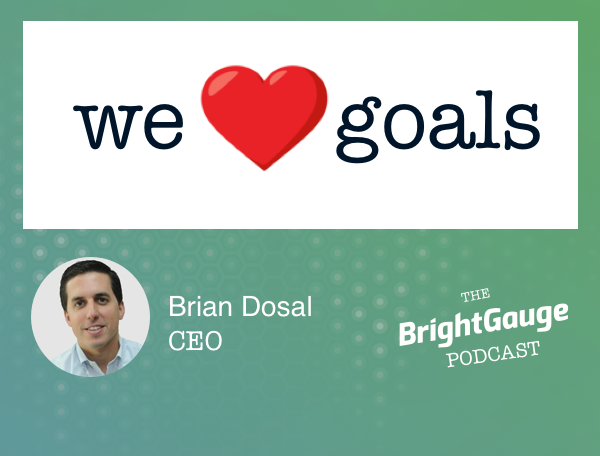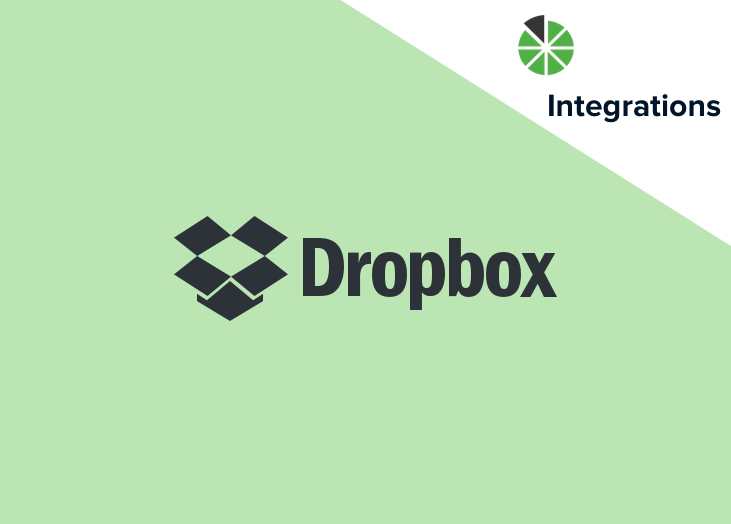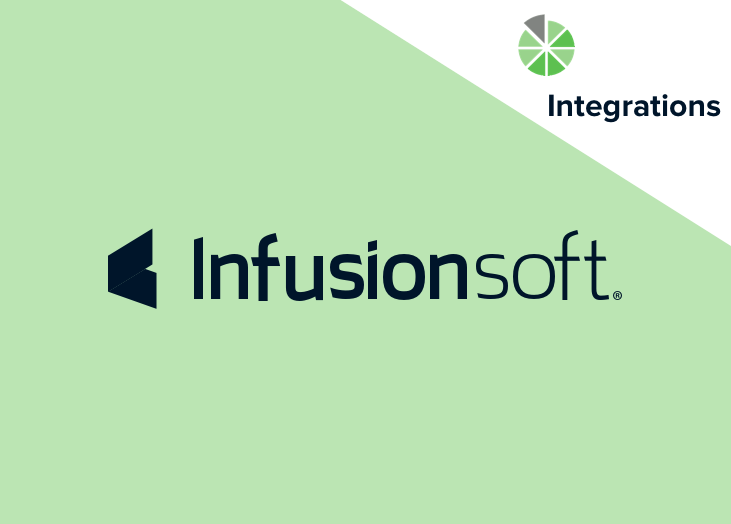
After turning to the EOS system back in 2016, BrightGauge found that there were a number of areas of our company we could improve to boost growth and employee happiness. Since reading Traction and implementing the EOS system, goal setting has been a big priority for our team, even making its way into our product. In this episode, Brian reviews why goals are important to any thriving business, and how to get started with them. Key takeaways Why goals are so important How Goals made it into BrightGauge Common mistakes made in goal setting It's ok to abandon your goal as long as you take what you've learned and have next steps planned out How to get the whole company to plan their future success with goals _____________ Transcript Danielle: So we formally launched Goals back in the Fall of 2017, and since then, we've seen a lot of users adopt and take on Goals for themselves, as well as run into a few questions about how to get started. So, today we're going to dive into how to set goals for every team member, while taking advantage of how this can improve your overall processes as a team, and lead to greater growth towards your company vision. So, Brian, why don't you just start us off a little bit with why goals, why are you so into goals? Brian: That's a good question. So the history of it in our product goes back further than 2017. We launched something called Scorecards in 2016, same time previous year, so it was a year earlier. And it really started with when I read the book Traction by Gino Wickman, and for those that have heard of Traction, or have not, I should say, it's part of the EOS system, Entrepreneurial Operating System. This gentleman wrote a book on how to basically run your company, and a big part of it was on using data to kind of keep an eye on things, and also to measure your success towards what you're trying to accomplish, so your goals. I love this concept, I took it exactly how he wrote in the book and we put it in the app itself, and then after a year of iterating on that, we realized that no one really understood what scorecards meant, or at least not in a way that we intended it to be, unless they had read the book specifically. So we transitioned to the feature that it really is, and that is just plain old goals. The reason I'm so into it is that I've been in this data world for 9+ years, and nothing has become more powerful in how we run our own internal business, in the sense of formalizing and committing to an internal set of things we want to get done with goals that are then measurable by data that exists in one of our systems, any of our systems. So I saw that first-hand when we were using spreadsheets before the scorecards came to our app in 2016, I saw our company that had 20 employees or maybe a little less really rally behind the few things that we needed to get done in a certain timeframe, and it was like magic. And we had all these dashboards up, we had all these reports going, and nothing impacted the behavior besides committing to a certain amount of things to get done, someone owning those things and having numbers to kind of manage it. So it's become kind of a passion for me in this odd sense, because it wasn't that I was ever big into school, I mean, I always wanted higher grades, but it wasn't like I had to hit this school I wanted to get into, or this degree. It was just kind of go with the flow in that sense but seeing it in practice in real life made me a huge convert of, goals is what makes a big difference. Danielle: So you weren't setting goals from day one, since you were born. Brian: No, no, no. I think, I mean even getting to school, it wasn't like I had to pick my top three and that’s where I went to, I just applied to a few schools that I thought would be interesting and kind of went for it. So it wasn't until running BrightGauge, and also seeing other companies adopted and feel the same way that I was like, this is real, this is really impactful, and then I just found an excuse to get it into our product. Danielle: Yeah, it's pretty easy to be aimless until you have the right process in place for effectively putting goals into place. Brian: For sure. Danielle: Otherwise, you set way too many of them, and none of them are achievable. Brian: For sure, and the biggest example is New Year's resolutions, I use it whenever I talk to people about why are goals important. It's very easy to set them, but in order to follow through, in order to hit them, in order to impact what you're trying to impact, you need to be held accountable. You have other people holding you accountable, which is why New Year's resolutions always fail. We were just talking about eating too much, and that's a thing that there's no one else holding you accountable, it's very hard to hold yourself accountable in the same way, so. Aimless is definitely something that every business is trying to fight. Danielle: So, why would you say goals are so important? It seems obvious in reaching a long-term objective, or even short term, but where does it really step into your company's profile? Brian: Yeah, and I guess goals in itself is not the important piece, right? That's the obvious reason, like you said, it's more how you implement it in your company, or in your team that makes it very powerful, and makes it important, because there needs to be a system in place that you as a manager, you as a leader implement in order to make sure that either the goals that are set are good ones, are the right ones, people are trying their hardest to hit them, and hopefully hitting most of them in that time period. So I would say goal management is super critical, and it's something that you can't take lightly and you need to make sure you're thoughtful in how you implement it in your team, and in your company. Danielle: So what would say makes these so essential to performing your best? It's clear how this is a motivating factor for companies overall, they want to see their vision put into place. Where would you say this fits in for individual improvement? Brian: Good question. So yes, at a team level, and as a leader, the goals are going to help you accomplish what you're collectively paying everyone to do together, right, as a team. Individually, they're a huge motivating factor because it helps create alignment, if done properly, it helps create alignment between what someone is doing individually, and how that aligns up with the company's goals. So when I say goal management, these are individually owned. So if the goal is we want to increase revenue by 10%, and someone in support would need to have some sort of goal that's attached to not losing any revenue, right? So their individual goal may be, make sure customer satisfaction's at 99%, they are kind of lasered in on that specific individual goal, they can see how that impacts the revenue goal for the whole company, and they can make sure they're doing a good job at their specific piece of the entire pie. So it's very motivating at all individual levels, because their impact should directly correlate with the broader theme of what the business is trying to accomplish. So it's that's sense of alignment that creates engagement with people, that are having these goals that are trying to hit them, that they can see why what they're doing is important. So it's a big part of successfully putting in goal management in your company is that everyone should be on the same. Everyone should be knowing what they can get done in their limited purview that then is going to impact the overall business. That's especially with millennial management, that's a huge part of like, how can they feel the impact that they make because they're two years out of school- Danielle: They want to feel like a champ. Brian: Right, they want to feel like a champion, exactly. And so it's hard to do, and these goal management concepts helps put that into place. Danielle: What were we doing before BrightGauge implemented goals? How were we managing that? Brian: So we were doing it haphazardly in the sense that we had these revenue targets that we wanted to hit, we still have the similar ones that we do today. But we'd say at the beginning of the year, hey, this is what we want to hit, x amount of net new customers. That was it, and now it's up to my brother and I when we were running the company to just make sure that everyone's doing their tasks, but when you're a small, six, five person, eight person company, everyone feels that sense of, they know what they're doing is helping that overarching goal. But we just had that one annual goal, and where we found friction, especially as we grew was, okay, what are we getting done this quarter that's going to help us get to that goal? Because you would end up, aimless is not necessarily the word I would describe ourselves at that time, but it was more, you're zigzagging, you're going in different directions when if you can just set out, these are the things I need to get done, knowing that my goal revenue is this for the whole year, that's where we kind of transitioned and when we started actually managing goals itself. So before the spreadsheets in 2016, we were all over the place, just with an annual target of what we wanted to get done, and with no real clear path to how we got there. Danielle: So at this point, we've taken it and we've applied to our company. How can other companies, BrightGauge customers use goals? Brian: Yeah, that's a question that I answered in those workshops, right, that we host at our offices. It's a common question. The easiest thing is just to get started, just as a team and hopefully the team leaders are doing this, they know where they want to get to in a certain time period, whether it's a whole year, whether it's three months in a quarter. You should say, okay, these are the projects I want to get done, this is what I want to accomplish, and this is how I want to measure those things that we can make sure that they say, yes, these are accomplished at the end of that time period, and then just get started with three or four. The biggest advice that I'd give to everyone is, it's okay that you're going to screw up the first quarter, you definitely will, I did, everyone does, it takes a lot of kind of getting into the right routine, how to set the right goals, how to cut your losses when they're wrong, because you don't want to just stick on the wrong thing because you put it on a piece of paper. So there's an adjustment period, so the best thing I'd tell you is to get started, write something down, assign them to people to be responsible for them, and then let it iterate from there. If you're flexible enough, it'll come pretty natural in the first, I want to say six months. It sounds like a long time, but in the grand scheme of things, you get pretty down with it. Danielle: So what timeframe are these normally being measured under? Brian: Three months is a standard. Jim Collins, Gino Wickman, even Google sets their goals, it's always quarterly. Sometimes you can do it every six weeks, instead of having four iterations a year, if you have eight iterations it helps you fine-tune the goal setting process. But six weeks may not be enough time to get something big done, so typically everyone says quarterly. Danielle: And if something doesn't feel quite right, you get so far along and the goal that you're tracking on a weekly basis. Brian: Yeah, abort mission. Danielle: And it's just not working. Brian: Well, case in point for you, you just switched roles within the company, so that wasn't a goal of mine to switch your team. [laugh] But it just happened, right? In the business, especially small businesses, things just happen, then your goals may change. It's okay to cut loose and say, okay, what are we trying to get done in the rest of the quarter or the next six weeks and come up with new goals. It's not about, you're not a prisoner to the goals you set, right? It's the other way around, and the people get lost in there, especially in the first two iterations where the purpose is to pick a few things to get done and try how to get them done. And with those things that are aligned to some longer-term goal of the company or the teams or the person or the individual, and so you just have to kind of maneuver yourself throughout the quarter, cut your losses, hey, maybe you picked a goal that's super easy, you get it done in three weeks, that was a good one, just keep iterating, add a new one, that time of thing. So it's a common question, and it's a common concern of people, but it's like, don't overthink it, because at the end of the day, it's just goals, right? It's just goal-setting. Danielle: Progress tracking. Brian: Yeah, progress tracking, and it's not a project management, it's not in that sense where you're delivering to a client. This is what you want to accomplish as an individual or a team to hit some big vision down the road, right? And it isn't just like, I need to deliver x, y, and z widgets for this customer. It's like, I want to change my business, my team's way of working in a year, okay, what do I need to do now, what are the steps to take to do at that point? Danielle: So what would you say makes for a good goal and ones where maybe we've failed ourselves? Brian: I've noticed that we are at BrightGauge, we always, not that we always, I shouldn't say that. I notice that we set very attainable goals, too much so, right, where we know we need to get it done, and so we set that as a goal, but we get it done in eight weeks out of twelve, and it's like, that didn't do anything, you weren't really pushing yourself. The purpose is to kind of stretch yourself out a little bit in order to feel comfortable that you can get to it and be okay if you can't get into it. And you can't get to it, meaning you can't accomplish the entire thing, but you get to 70% of the way there. Google forces every single person to have goals, at least three in a quarter for each individual. But they want you to be 70% of the way there, so they don't want you setting goals that are easily attainable. So, that happens to us all the time. I think a good goal is something that is measurable, that there's some way of saying, yes, this is complete, but still inspirational, or aspirational in that everyone understands the broader theme behind it. So you being on the new success team, you know a good goal would have been like form a new success team, as measured by hire someone, implement 50 tracking calls, do this, so that everyone knows, hey, what we're trying to do is implement a new success team, but then tactically, you know these are the one, two, three things that you need to get done. Danielle: You can break it down by individual tasks, and I noticed a lot of goals are made up of one task, and it's pretty easy to just look at it through that linear view. Brian: Yeah, exactly, but there's a couple different philosophies for goal setting and this is where it gets kind of interesting, which I like, the Gino Wickman Traction model, EOS, is one specific way to track goals, and it's very much like you just kind of said of where, it's smart goals, they're specific, they're measurable, attainable, whatever the rest of the letters mean. Time down, so that's one way to do it. The other way which is a more popular way nowadays is called these OKRs, which Google has popularized, it started way back at Intel, and this is where you have an OKR, which stands for Objective, and then the KR is Key Results, and where you have this statement that's like, I want to change the world, or something a little bit smaller, I want to change my world. And then you have the key results which are the specific kind of, like you said, tasks, those are very much measurable. So everyone has three or four of these big goals that you can rally around, you can wrap your head around, you know it's important. You have some wiggle room in that, and you have specific, all right, let's get these things done to it. So that philosophy is very different than a lot of our listeners and customers that use it, but it's a very interesting way to set goals, as proven by Google doing it, since close to their inception, which they now credit much of their success, not just on the algorithm for searching, but for OKRs in the business, which is crazy. Danielle: And how would you say, because not every individual on your team is going to be able to choose a goal for themselves? Brian: They should, they should. So they should, each individual should come up with their own goals because the secret being, if they come up with it themselves, they feel more connected to it. So when if it comes top down, you're going to have people that just say, ah, I don't care, I don't believe that this should be the right thing. So you want everyone to kind of set their own goals, but just make sure that everyone's online with what we want to get done, and just that conversation itself helps everyone stay on the same page. If you can maneuver, or manipulate the situation to say, hey, let's try, yes, you want to take these four certification exams, but it doesn't really tie into where we're heading, how about let's take one of those exams, let's do this other thing, now you have a good conversation with the person and they feel invested in it, and you're making sure that they're doing, kind of focusing on the right thing. So you definitely want them to be part of the process. Danielle: Yeah, in talking to a few of our customers, I've noticed that it's not always the case, that's definitely not the case. Brian: Yeah, because they think very top-down, especially there's a lot of engineers that our customers have on staff that use our product, so it's very much like, these are the five KPIs that I want you to hit every week. That's not really making goals, in a sense. That's just making sure that they're doing their job, what are they trying to accomplish in those, what's really a thing that pushes them to get something done, and you can't throw that down to them. They have to be part of that conversation for it to be truly successful. Danielle: Yeah, I love going through a lot of the different BrightGauge teams' goal lists and seeing not only is it something directed towards how they can do better in their position, be it hit a certain mark, close a certain amount of tickets, but a lot of it is towards self-betterment, self-improvement, and growth within the goal as well. Brian: Yeah, I mean, the self-betterment ultimately helps the company as well, so we 100% support it, most people should, where if it's a, I want to be better at ownership for a senior dev that we have on this team, that's awesome, we want him to be better at ownership, so it's part of scaling our team, he knows that he wants to get better, right? So it's just this great relationship that we have, and everyone's vested in this thing. Danielle: Seems pretty clear why we built goals into BrightGauge, we have dashboards and reports to go along with it. How do you tie all of that back together? Where did this really step into- Brian: Because everything is measurable, everything is measurable, and at the end of the day, what we're trying to accomplish here is helping these small companies, that's just like MSPs, run a better business, and data is a big part of that, real-time data is a big part of that, but it's the numbers that are attached, the measurable-ness of a goal that ties it very much back to BrightGauge, and a mission like, let's help these people run better businesses. So to link that, sometimes people get confused, like, this is so different, and it is, but when you break it down and streamline it, at the end of the day it could be based off of KPIs, it's very much measurable, it's very much your own data, and so that's where we see it fit in what we're trying to accomplish. Danielle: And so by your own data, you need looking at not only sales numbers, service to get numbers, but also on the operational side, something that you can extend to the whole team, everything's measurable. Brian: Everything should be measurable that you're tracking, and so at BrightGauge, we're adjusting as many data services as we can, so it's that same philosophy of, if there's numbers behind it to help you manage your business, that's where we want to be in, where we want to plan. So, that's how it ties back again, it's different mentality than thinking about a dashboard where you put it on a big screen, and that's it. Behavior does change in that situation, but goals is a different way to do the same thing, which is to improve and change behavior. Danielle: So how can folks start using goals? Brian: Well, if you're a current customer, it's already there for you in the product itself. There's a lot of these, it's that getting started part that people get stuck on. We did build in the app this inspiration feature where curated goals by other service providers are there for people to just pick off and say, oh, let me try this, this, and this. So that's a good way to get started. If people are really stuck, they can reach out to us in support, I'd even get on the call with them and talk through what they're trying to accomplish and help out, but it's just about kind of getting started and committing to it, it's the best way to get going. And even if you don't use BrightGauge and you're listening in, use a spreadsheet, that's what most people are using. Just track them, write them down, assign someone to a goal, and just iterate from there. Make sure it's attached to some longer-term vision, but just get started. You can always start with Excel. Danielle: Yeah, you might already be using a spreadsheet to track revenue or billing. It's kind of the same principle, really. Brian: Most people, I mean I'd say, I think we have 300 active goal users, I don't know if that's an appropriate way to say it, but goal companies, companies using goals, I guess is a better way. And I know it takes awhile, because spreadsheets, typically they come from people that are using spreadsheets and doing all right. So spreadsheets is just the fastest way, but if you want to get started with BrightGauge, it's easy as well, it looks very similar to a spreadsheet, but it just has built-in reminder features, and a built-in, sending out an email to everyone at the end, kind of helps that staying in sync part of it, but either way, just get started. Danielle: The beauty of the goals that you've set too are that they automatically snapshot, so they goal where you currently stand. Brian: Yeah, and BrightGauge, that's a huge value add, and it saves a lot of time. So if it's pulling from a number that exists already in our system, or being sent to our system, BrightGauge will take a snapshot of it, and then you have that stored data, so the person doesn't have to go and look for the data, and what was my revenue number last week, or what was my service ticket number? They can go in and it's already there, you just provide the context around why that number is what it is. Danielle: So with the context, you can just go in and add a little note next to the number, if you're on track or off track. Brian: Yeah, it's awesome. In a sense, so me as the business owner, and as a team lead as well, when your whole team is putting in, checking in, putting in a context or a note, right, around that check-in, it then emails you at a certain time when they're all done, and so you can get a quick snapshot of how everyone's doing across their goals. You know that their goals are still top of mine, so the system part of it is a huge benefit, but again, for people just getting started, I mean, use us, obviously, please, but you can always use Excel if you want to try something. Danielle: And what would you say, just for those who aren't familiar with BrightGauge goals, the difference between the two we offer process goals, and outcome goals? Brian: Good question. So there's two different, again, goal philosophies is very, it's incredibly debated, and it's been around since Peter Drucker wrote a book in the 50s or 60s, I hope that's right. But when you break it down, one delineation we saw is that you have two different types of goals, and one is this outcome goal, which is a traditional, hey, I want to lose five pounds by the end of the quarter, or by the end of the year. And then you have this other process goal, which is more of the, in order to hit that outcome goal, you have to be doing certain things. If I want to lose five pounds, I'd better be working out three times a week. I'd better be eating salads five times a week, whatever the process is to get to that outcome goal. So we see that a lot in our companies where they have these aspirational outcome goals, but there's no thought to the process to get there. And so we have these process goals that help people think that way, that like, hey, that's great, I want to get to this, I want to sign up 20 new customers, but I need to make sure that I'm making calls, I'm doing networking lunches, and I'm doing a process in order to get there. So those are the two differences, and we put that in the app, so it's clear what's what. Danielle: So if you were to take that and apply it to say one individual sales team member, it could have an outcome goal of 20 signups, or new revenue for the month, and then underneath it have a few separate key outcome goals, process goals. Brian: That gets you there, right? And it could be dials, sales is definitely a great example. They have to have activity in order to generate what they get paid on which is the revenue. So they could have, I want to hit 10,000 monthly recurring revenue, okay, well, they need to be doing, ten dials, three prospect lunches, those things, and it could be a sub-goal, it all depends on how you want to install the framework in your company, the system, the goal system, but they go hand in hand, or they could be totally separate in the sense that you just want to keep track of making sure that the business is running those process goals. Danielle: Thinking of that now, what advice would you give to business managers, owners, looking to implement this system into your company without making it feel like such a chore for those employees who might already. Brian: Yeah, it's a good question, because it's always, again, the hardest part is getting started, but the reality is, everyone's going to enjoy the concept of full transparency between what the business owner is doing, what their job is as the service technician, sales person, etc. So if the business owner is taking this seriously, is sharing how his progress to his goals, which he or she should have announced to the team, you'll get the behavior from everyone else to pick up behind that. So I think that's a good piece of advice, make sure that the business manager is actively participating in the goals as well, and sharing them, and being transparent, and that'll create that camaraderie and that buy in from everyone that you need in order to make this happen. I mean, I get jazzed up by this stuff, it's a very magical experience when you see people working towards a similar thing, but in their specific purview, and it happens in sports all the time, it happens in big companies, small companies kind of have the same feeling, if they do this the right way. Danielle: Definitely. Is there anything that you think would be helpful to share? Brian: There is a new book that just came out by John Doerr, I believe that's how you pronounce his last name, and it's a book, he was one of the early investors in Google, and he just wrote a 300 page book on essentially goal-setting, and how Google used it as well as other organizations that he's invested in. And I would pick that up because when people think of goals, they think of stagnant, not purposeful, kind of big company thing, but hearing the tech industry talk about it, in their cool, hip way, is very motivating. So take a look at that new book that just came out, it's called Measuring What Matters, and that's a great resource. The Traction book is fantastic, Google about goals, and see what people are doing. But it's powerful, it's a simple concept, it makes sense, everyone kind of has goals in the back of their mind, but it's all about how you implement it at your company and the system you use, so just keep learning about it and keep iterating. Danielle: Great, and if you have any questions about where to get started with goals, especially at BrightGauge, or even if you want to talk to us about some of the goals that you've been setting yourself, you can reach out over at support@brightgauge.com. Brian would be happy to take a peek- Brian: Yeah, great, email or call us, and there's a bunch of blogs that we've written and whitepapers on how to set goals, how to fix things when you set the wrong goals, or you set too many goals that are too attainable. So we have a bunch of resources out there for that but always just reach out. We're always happy to chat, especially on this, I love this stuff. Danielle: Great, thank you so much. Brian: No problem, thank you.












